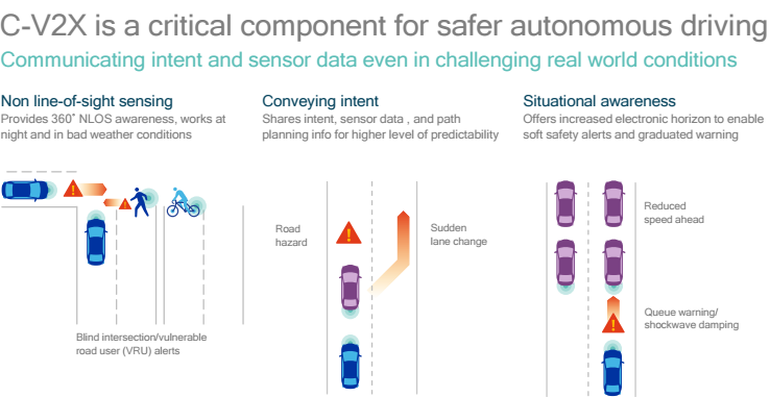
By Heather Hamilton, contributing writer
Qualcomm just announced that the secret to safer self-driving cars is perhaps upon us, introducing a chip that is cellular and DSRC, allowing information that is both time-sensitive and not to be relayed between sources. The Qualcomm 9150 C-V2X cellular vehicle-to-everything (V2X) chip should be available in small numbers to automakers beginning in the second half of 2018 with a reference design to encourage timely production.
The chip integrates DSRC radio while allowing the vehicle’s telematics system to handle cellular, which solves some very real problems with driving, bringing us closer still to the type of communications system necessary for a fully autonomous vehicle. Because most accidents are caused by driver error, the need for cars to communicate with one another to relay information about things like skids, breaks, and lane changes is great.
The press release says that Qualcomm’s commercial solution is based on 3rd Generation Partnership Project Release 14 specifications for PC5-based direct communications and the Qualcomm C-V2x Reference Design, which features the 9150 C-V2x chipset with GNSS integration, and it includes an application processor that runs the Intelligent Transportation Systems V2X stack and a Hardware Security Module.
According to Extreme Tech, when such information is communicated, V2X systems can respond appropriately after alerting a vehicle’s driver, making the roads safer. The car’s response would change based on what was happening around it — for example, a car may not deploy breaks quickly if a car is tailgating, instead opting for a lane change. V2X communicates with other cars, which includes vehicle-to-vehicle (V2V), vehicle-to-infrastructure (V2I), and vehicle-to-pedestrian (V2P) via phone. So traffic signals could give information about light changes, V2I transceivers might alert a car to construction, and a mobile unit could give a driver notice of an accident. Qualcomm 9150 C-V2X was built to complement other Advanced Driver Assistance Systems sensors, including cameras and LIDAR and radar.
By detecting and exchanging information using low-latency transmission in the globally harmonized 5.9-GHz ITS band scenarios without the need for a SIM, cell subscription, or network assistance, Qualcomm hopes to utilize the wireless operator’s 4G and eventual 5G networks. In a press release, they write, “The C-V2X standards include both the global 3GPP specifications at the radio layers and reuse the established service and application layers defined by the automotive industry, including the Society of Automotive Engineers (SAE) and European Telecommunications Standards Institute ITS (ETSI-ITS), who utilize investments made by the ITS community, allowing for evolution of the upper layers to support new and enhanced capabilities.”
Nakul Duggal, vice president of product management at Qualcomm says of the project, “Today’s introduction of the Qualcomm 9150 C-V2X chipset builds on our leadership in automotive technologies, demonstrating our continued commitment to design and offer advanced solutions for safe, connected, and increasingly autonomous vehicles. With its strong synergy with telematics and an evolution toward 5G, C-V2X offers benefits to the automotive industry by developing new capabilities for improving road safety and enhancing autonomous driving and advanced connected services while building on the ITS momentum and investments made over the last decade. C-V2X is expected to support safer roads, increase productivity, and decrease traffic congestion. We look forward to seeing our 9150 C-V2X chipset play a key role in assisting the global market to achieve these benefits.”
Qualcomm’s automotive partners include Ford, Audi, SAIC, and the PSA Group.
Sources: Qualcomm, Qualcomm Press Release, Extreme Tech
Image Source: Qualcomm
Advertisement
Learn more about Electronic Products Magazine





